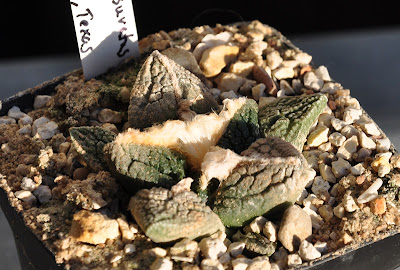
Winter dormant peyote cactus
Following a relatively mild period the last couple of years have seen freezing cold winters here in Denmark - winters that have been tough to my coldhouse grown plants, and especially the deep frost of 2009/2010 killed off a significant number of my coldhouse collection. But it also separated the wheat from the chaff leaving a pretty cold-hardy assemblage of plants, the dormant Lophophora williamsii var. echinata (JJH 8608293; Pecos River area) pictured above being a majestic example.

Ariocarpus kotschoubeyanus var. macdowellii (SB 100; El Pilar, Coahuila)
Most of the cacti growing in the coldhouse are selected for their (sometimes assumed) ability to survive freezing conditions. For example I prefer the Trans-Pecos variety of peyote as it is more frost hardy than the tender regular variety - and the different Ariocarpi all originate from the northernmost part of the species’ respective ranges.

Ariocarpus fissuratus (SB 403; Crockett Co, Texas)
Even though the cacti already have survived several cold winters I can’t deny that I still worry what plants will die off during winter (as some inevitably will).
The pictures appearing in this post were taken between Christmas and New Year - at that time the plants had already been exposed to temperatures in the vicinity of -10 C (approximately 14 F). Since then they have seen both mild and humid weather and long periods of frost - I expect that these fluctuations in temperature are harder to cope with for the plants than uniform periods of cold, but it’s just a hunch. Anyway I’m eagerly looking forward to spring :-)

Ariocarpus retusus (SB 310; Cuesta la Muralla, Coahuila)
But it is not just the cold that poses a threat to my plants. Previously critters have eaten large bites out of some of my peyote plants and now several of my Normanbokea valdeziana plants have met the same destiny... I still haven’t figured out what culprit is eating my cacti (or at least tasting and spitting out again)!

Normanbokea valdeziana (SB 1468; Ramos Arizpe, Coahuila, Mexico) eaten into by some unknown critter
Malpighia 1927 v.30 (added: 11/24/2025)
-
*By:*
Borzi, Antonino,1852-1921.
Penzig, O.1856-1929.
Pirotta, Romualdo,1853-1936.
*Publication Info:*
Messina : g. Capra & co., 1887-89 ; Genova : Tip. di A...
2 weeks ago



















Those are some great looking Ariocarpus. I can't wait until my Ariocarpus look like these. They are pretty slow growing even when grafted. Love your blog, keep it up.
ReplyDeleteYes, Ariocarpus are cacti for the young (or young at heart) as Bill Weightman said :-) I'm quite impressed by your Pereskiopsis grafting experiment and interested in knowing how the Ariocarpi will fare once degrafted.
DeleteI will keep you posted, though it might be a while before I get to that stage (have I mentioned they are slow-growing? lol). I grafted some Fissuratus recently, and they are doing good (as far as Ariocarpus goes)...I really love the Fissuratus especially...I am thinking maybe a different rootstock might serve the Ariocarpus better??? I have some Myrtillocactus and Hylocereus grafted to pereskiopsis as well as potential rootstocks..If you have any advice in this area it would be most appreciated.Thanks in advance.
ReplyDeleteP.S. Thank you very much for your coorespondence...It means a lot when someone who has been involved as long as you have is willing to share wisdom with and give complements to newcomers (comparatively speaking)...Keep up the great work.
-Cacti Guy
A. fissuratus is one of my favorites as well but I have never grown them as grafts. As the majority of my Ariocarpi are growing in an unheated greenhouse (in rather cold Denmark) I have found it wiser to let the plants stay on their own roots. I once considered grafting seedlings onto Opuntia compressa stock plants (that are extremely freeze-hardy and allegedly should ensure a natural, "slow-growing" look) but never got around to it. My preferred grafting stock would be Trichocereus pachanoi (San Pedro cactus) or T. peruvianus (Peruvian Torch cactus) as they are fast growing, long-lived, and their sticky sap makes them easy to graft e.g. seedlings onto (seedlings grafted onto a Trichocereus pachanoi stock is also a wonderful example of applied laziness - you just graft the seedling and can sit back and relax, watching it grow for many, many years to come :-)
ReplyDeleteAs mentioned I like your approach of kick-starting (more or less, it seems) everything with your forest of Pereskiopsis - I've previously experimented with Pereskiopsis spathulata as the grafting stock for peyote seedlings but never really got the hang of it. That being said I still have a few Pereskiopsis plants growing so I might be inspired to take it up again :-)